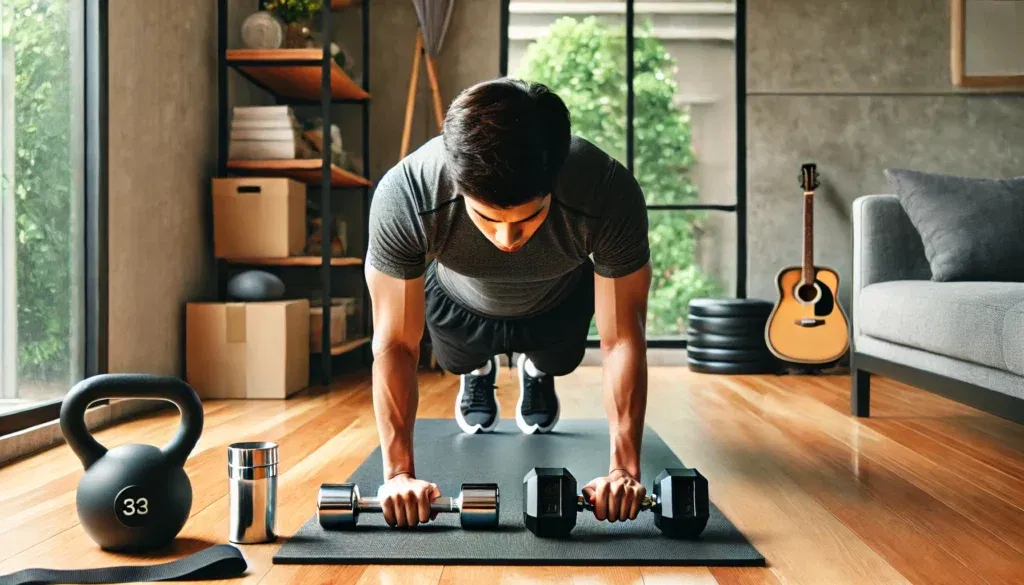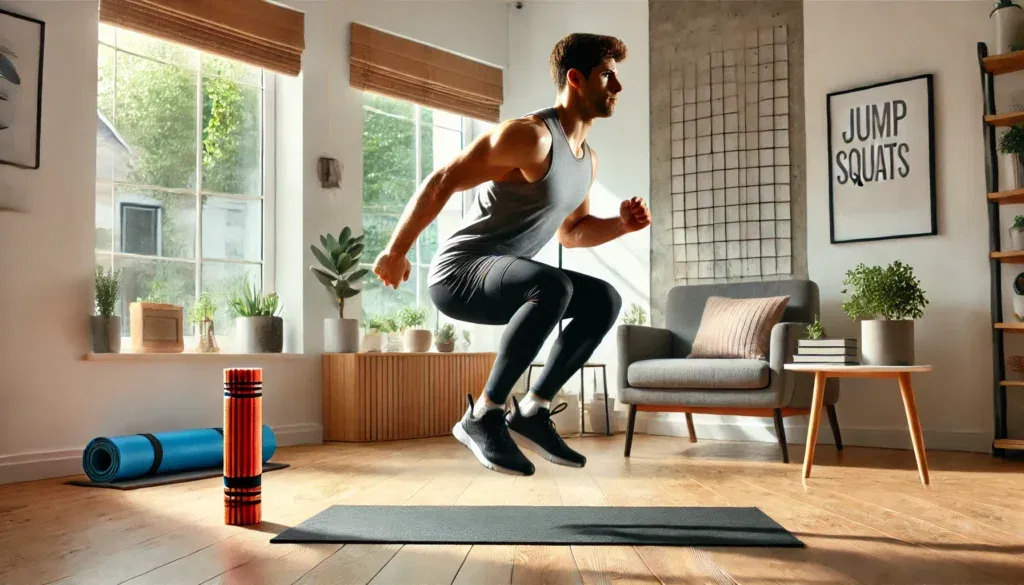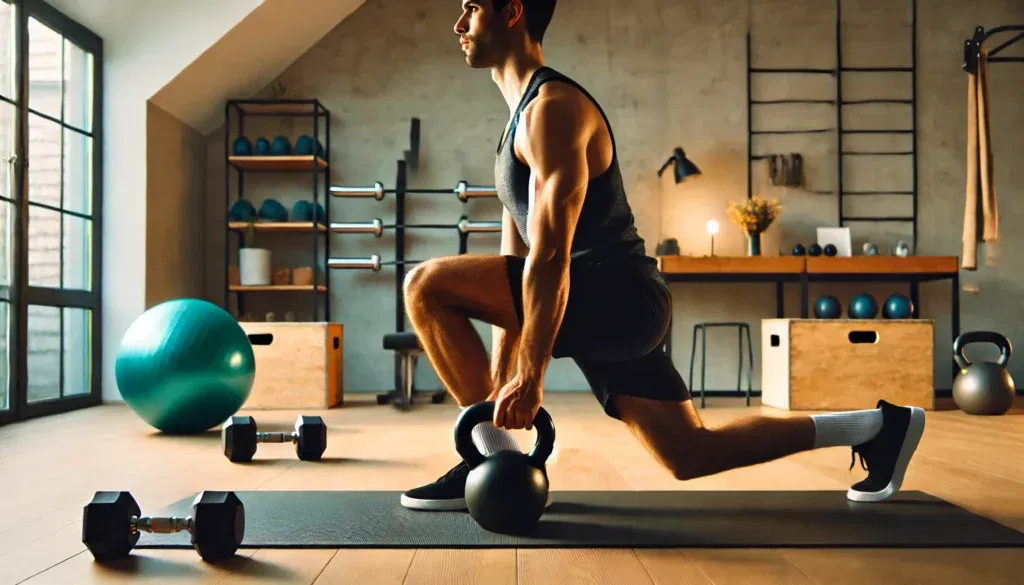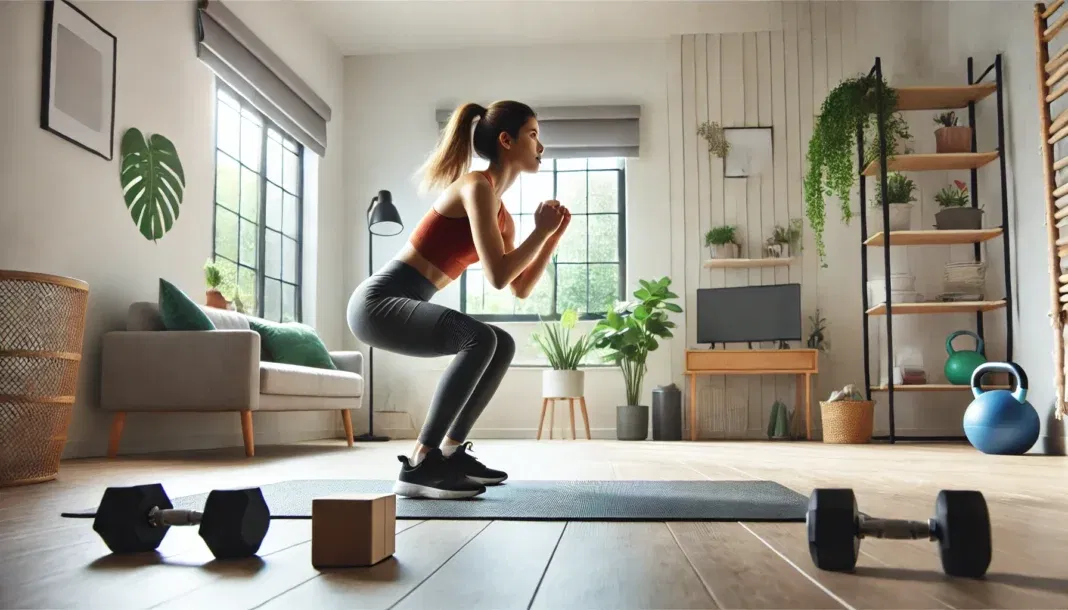Introduction: The Importance of Diverse Exercise in Home Fitness
In today’s fast-paced world, many individuals struggle to find the time or resources to commit to a gym membership or structured fitness program. Fortunately, a highly effective and diverse fitness routine can be built from the comfort of home, utilizing a variety of exercises to target strength, endurance, flexibility, and overall performance. By engaging in 20 different types of exercises at home, individuals can create a well-rounded fitness regimen that promotes long-term health, reduces the risk of injury, and enhances physical capabilities.
You may also like: The Ultimate Bodyweight Workout Routine for Full-Body Strength and Performance
Home-based fitness routines are not only convenient but also adaptable to different skill levels and goals. Whether you are a beginner looking to establish a foundational exercise routine or an advanced athlete seeking to improve performance, incorporating a diverse set of movements can enhance your physical conditioning. The following discussion explores 20 different types of exercises, each providing unique benefits, ensuring a comprehensive approach to fitness, and optimizing overall well-being.
Bodyweight Exercises: The Foundation of Home Workouts
Bodyweight exercises are essential for anyone looking to improve fitness without the need for specialized equipment. These movements leverage one’s body weight to build strength, endurance, and mobility while promoting functional fitness.
Push-Ups: A Classic Upper-Body Strengthener
Push-ups are one of the most effective exercises for strengthening the upper body, particularly targeting the chest, shoulders, and triceps. They also engage the core, making them a comprehensive movement for overall stability. Variations such as wide-grip push-ups, diamond push-ups, and decline push-ups add diversity and challenge to the exercise. Performing push-ups consistently helps improve muscular endurance and contributes to better posture and functional strength.
Squats: Building Lower-Body Strength and Stability
Squats are fundamental for developing leg strength and improving overall lower-body functionality. They engage the quadriceps, hamstrings, glutes, and core, making them an essential movement for daily activities such as walking, climbing stairs, and lifting objects. Variations like sumo squats, jump squats, and pistol squats enhance muscle activation and provide progression for different fitness levels.
Planks: Core Stability and Endurance
Planks are a crucial exercise for core stability and endurance. They engage multiple muscle groups, including the abdominals, obliques, lower back, and shoulders. Variations like side planks, plank leg lifts, and forearm planks offer progression and challenge. Incorporating planks into a routine strengthens the core, improves posture, and enhances overall athletic performance.
Lunges: Enhancing Balance and Leg Strength
Lunges are highly effective for building unilateral leg strength, improving balance, and increasing flexibility. By stepping forward, backward, or laterally, different muscle groups are engaged, making lunges a versatile exercise. Adding dumbbells or increasing the range of motion intensifies the movement, leading to greater muscle activation and endurance gains.
Burpees: A Full-Body Power Move
Burpees are an intense full-body exercise that combines strength and cardiovascular training. They involve a push-up, squat, and jump, making them a powerful calorie-burning movement. Performing burpees regularly enhances cardiovascular endurance, agility, and total-body strength. Variations such as half-burpees and burpee tuck jumps allow for scaling the intensity based on individual fitness levels.

Resistance Training: Strength Building at Home
Incorporating resistance training into home workouts enhances muscle strength, endurance, and overall functional fitness. While bodyweight exercises provide a solid foundation, adding resistance bands, dumbbells, or household items as weights increases the challenge and effectiveness of strength training.
Dumbbell Deadlifts: Strengthening the Posterior Chain
Deadlifts are essential for strengthening the posterior chain, including the lower back, glutes, and hamstrings. Using dumbbells at home allows individuals to perform this compound movement safely while improving overall strength and posture. Proper form is crucial to maximize benefits and prevent injury.
Bicep Curls: Isolating Arm Strength
Bicep curls target the upper arms, improving muscle definition and strength. Using dumbbells or resistance bands, individuals can perform variations such as hammer curls and concentration curls to engage different parts of the biceps. Consistent practice enhances grip strength and arm endurance.
Shoulder Press: Developing Upper-Body Power
The shoulder press is an effective movement for strengthening the deltoids, triceps, and upper back. Whether performed with dumbbells or resistance bands, this exercise enhances shoulder stability and power. Maintaining proper form ensures maximum muscle engagement and prevents strain.
Triceps Dips: Sculpting the Upper Arms
Triceps dips are an excellent exercise for targeting the triceps and improving upper-arm strength. Using a sturdy chair or bench, individuals can perform dips to enhance arm definition and endurance. Modifications such as adding weight or adjusting hand placement provide progression.
Cardiovascular Workouts: Boosting Heart Health and Endurance
Cardiovascular exercises play a crucial role in improving heart health, increasing stamina, and promoting overall fitness. Performing cardio workouts at home eliminates the need for specialized equipment while providing substantial health benefits.
Jump Rope: A High-Intensity Cardio Challenge
Jump rope workouts provide an excellent way to improve cardiovascular fitness, coordination, and agility. Different jump variations, such as single-leg jumps and double unders, increase intensity and skill development. Regular jump rope sessions enhance endurance and calorie burn.
Mountain Climbers: Full-Body Cardio Conditioning
Mountain climbers engage the entire body while providing an intense cardiovascular workout. This exercise strengthens the core, shoulders, and legs while boosting heart rate. Performing mountain climbers at a fast pace enhances speed, agility, and overall endurance.
High Knees: Elevating Heart Rate and Agility
High knees are a simple yet effective way to improve cardiovascular fitness and lower-body endurance. Performing high knees at varying speeds increases intensity, making it an excellent addition to a home cardio routine.
Stair Climbing: Strength and Endurance in One Move
Utilizing stairs for workouts enhances leg strength, cardiovascular endurance, and overall fitness. Running or walking up and down stairs adds resistance and engages multiple muscle groups, making it a practical home-based exercise.
The remaining sections will continue exploring additional exercise modalities, including flexibility training, plyometric movements, and mindfulness-based practices like yoga and Pilates. These approaches ensure a well-rounded fitness regimen that addresses all aspects of physical health and performance.

Frequently Asked Questions: Enhancing Fitness with 20 Different Types of Exercises at Home
1. How can I structure a balanced workout routine using 20 different types of exercises at home?
Creating a balanced workout plan using 20 different types of exercises at home involves a strategic combination of strength training, cardiovascular workouts, flexibility exercises, and functional movements. Ideally, workouts should be structured around a weekly schedule where different muscle groups are targeted on different days. A well-rounded routine could include bodyweight exercises such as push-ups, squats, and lunges on strength days, while reserving high-intensity workouts like burpees and jump rope for cardiovascular conditioning. Incorporating yoga or Pilates sessions ensures flexibility and recovery, reducing the risk of injury while enhancing mobility. By varying these exercises regularly, you can prevent workout plateaus and continue progressing toward your fitness goals.
2. What are some common mistakes people make when doing 20 different types of exercises at home?
One of the most frequent mistakes people make when incorporating 20 different types of exercises at home is neglecting proper form, which can lead to injuries over time. Many individuals also fail to create a structured routine, leading to overtraining some muscle groups while neglecting others. Another common issue is skipping warm-up and cool-down sessions, which are essential for preparing the body and preventing soreness. Additionally, some exercisers do not progressively challenge themselves by increasing intensity or resistance, limiting their long-term progress. To maximize results, it is crucial to pay attention to form, follow a balanced program, and gradually increase workout intensity.
3. How can I stay motivated to maintain a routine with 20 different types of exercises at home?
Staying motivated while doing 20 different types of exercises at home requires setting clear fitness goals and tracking progress regularly. Creating variety in workouts helps prevent boredom, so integrating new movements or switching between different exercise styles can keep routines engaging. Accountability also plays a crucial role—joining online fitness communities or partnering with a workout buddy can provide encouragement and support. Rewarding progress, whether through fitness milestones or personal incentives, reinforces commitment to the routine. Finally, reminding yourself of the long-term health benefits, such as increased energy levels and improved mental well-being, can serve as a strong motivator.
4. Are 20 different types of exercises at home enough to build muscle effectively?
Yes, incorporating 20 different types of exercises at home can be highly effective for muscle building, provided they include progressive overload and variety. Strength training exercises such as squats, lunges, push-ups, and triceps dips can effectively stimulate muscle growth when performed with proper intensity and technique. Adding resistance, whether through bodyweight progressions, dumbbells, or resistance bands, ensures continuous challenge and muscle adaptation. Consistency is key, as well as maintaining a protein-rich diet to support muscle recovery. Over time, increasing repetitions, duration, or resistance will further enhance muscle development and strength.
5. What are the best ways to modify 20 different types of exercises at home for beginners?
For beginners, modifying 20 different types of exercises at home involves reducing intensity and gradually increasing complexity as fitness levels improve. Starting with modified push-ups on the knees, assisted squats using a chair, and slow-paced lunges can make movements more accessible. Focusing on shorter workouts with longer rest periods allows the body to adapt without excessive strain. Using household items such as water bottles for resistance or opting for low-impact movements can also help beginners build strength safely. As confidence grows, incorporating more advanced variations and reducing rest time can lead to gradual progress.
6. How can I avoid muscle imbalances while performing 20 different types of exercises at home?
To avoid muscle imbalances, it is essential to ensure that all major muscle groups are engaged equally when performing 20 different types of exercises at home. Many people tend to overemphasize certain muscle groups, such as focusing on push exercises (push-ups) without incorporating enough pull movements (rows). A balanced workout should include compound exercises that target multiple muscle groups and unilateral movements, such as single-leg squats and lunges, to correct imbalances. Additionally, incorporating flexibility and mobility work can help maintain proper alignment and prevent compensation patterns. Tracking workout variations and adjusting exercises regularly ensures a well-rounded approach to muscle development.
7. How can I increase the intensity of 20 different types of exercises at home without equipment?
Increasing intensity while performing 20 different types of exercises at home without equipment can be achieved through several techniques. One effective method is tempo training—slowing down movements to increase time under tension, such as performing squats with a three-second descent. Another approach is incorporating plyometric variations, such as jump squats or explosive push-ups, to enhance power output. Increasing the number of sets, repetitions, or reducing rest periods can also elevate workout difficulty. Additionally, performing supersets—pairing two exercises back-to-back—challenges endurance and maximizes muscle activation. Implementing these strategies ensures continuous progression and adaptation.
8. How can I incorporate recovery techniques when doing 20 different types of exercises at home?
Proper recovery is crucial for preventing injury and maximizing performance when doing 20 different types of exercises at home. Active recovery techniques, such as foam rolling and stretching, help alleviate muscle tightness and improve flexibility. Prioritizing adequate sleep and hydration ensures muscle repair and optimal function. Alternating between high-intensity and low-intensity days allows the body sufficient time to recover while maintaining consistency in workouts. Incorporating mindfulness techniques, such as yoga or breathwork, enhances relaxation and aids in overall recovery. A well-balanced diet rich in proteins, healthy fats, and carbohydrates also plays a significant role in post-exercise recovery.
9. Can 20 different types of exercises at home help improve athletic performance?
Absolutely! Performing 20 different types of exercises at home can significantly improve athletic performance by enhancing strength, endurance, agility, and flexibility. Functional exercises that mimic real-life movements, such as lunges and dynamic stretches, improve overall coordination and reduce injury risks. High-intensity interval training (HIIT) incorporated into home workouts can boost cardiovascular fitness, leading to better stamina in sports and physical activities. Strength-based movements improve power output, while mobility drills contribute to enhanced range of motion. A well-structured home workout plan can complement athletic training and lead to improved performance in various sports and activities.
10. What role does mental discipline play in sustaining a routine with 20 different types of exercises at home?
Mental discipline is a crucial factor in maintaining consistency when incorporating 20 different types of exercises at home. Developing a strong mindset helps overcome challenges such as lack of motivation, distractions, or plateauing results. Establishing a routine and treating workouts as non-negotiable commitments ensures long-term adherence. Practicing mindfulness techniques, such as visualization and goal-setting, fosters a positive attitude towards exercise. Understanding the mental benefits of regular physical activity, including stress reduction and enhanced cognitive function, reinforces the commitment to maintaining a fitness regimen. Ultimately, building mental resilience translates into greater physical performance and overall well-being.

Conclusion: Crafting a Comprehensive Home Fitness Plan
A well-rounded home fitness routine incorporates strength training, cardiovascular conditioning, flexibility exercises, and mindfulness-based movements. By integrating 20 different types of exercises at home, individuals can achieve balanced fitness, enhance performance, and maintain overall health without the need for a gym. Consistency and progression are key factors in optimizing results and preventing plateaus. Committing to a structured routine that includes a variety of exercises ensures long-term success in fitness and performance.
home fitness, bodyweight exercises, resistance training, cardiovascular workouts, functional strength, high-intensity workouts, endurance training, flexibility exercises, yoga for fitness, muscle endurance, strength building, core stability, fat loss exercises, agility drills, balance training, at-home strength training, HIIT workouts, plyometric exercises, holistic fitness, overall wellness.
Further Reading:
20 Different Types of Exercises to Boost Your Fitness [2024]
Starting a Fitness Routine? 20 Different Types of Exercise to Consider
20 Best Effective Exercises for Every Level and Age
Important Note: The content provided by HealthXWire is for informational purposes only and should not be construed as medical advice, diagnosis, or treatment. While we strive for accuracy, the information presented on this site may not reflect the most current research or medical guidelines. Always seek the advice of your physician or other qualified health provider with any questions you may have regarding a medical condition. HealthXWire does not endorse, recommend, or guarantee the efficacy of any products, services, or treatments mentioned on this site. Users should not disregard professional medical advice or delay seeking it because of something they have read on HealthXWire. HealthXWire is not liable for any damages, loss, or injury arising from reliance on the information provided herein.



